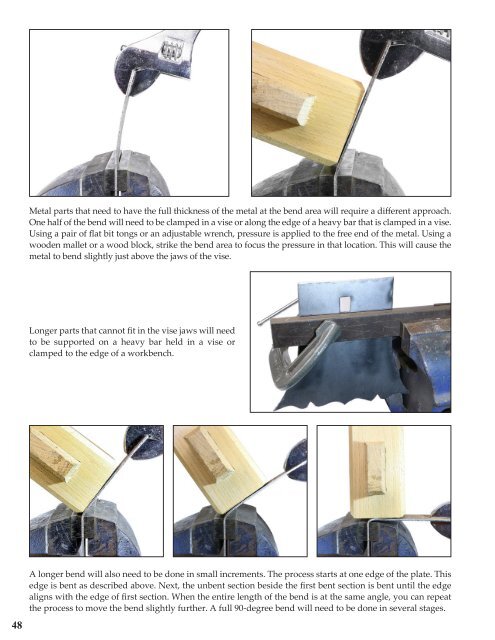The New Spruce Forge Manual of Locksmithing: A Blacksmith’s Guide to Simple Lock Mechanisms
The New Spruce Forge Manual of Locksmithing: a Blacksmith’s Guide to Simple Lock Mechanisms is a totally revised and expanded version of the original work from 1999. This new hardcover edition, at 304 pages and with more than 800 color photos and illustrations, is more than double the size of the original manual. It is divided into two distinct sections: Technical Information - This section is a reference manual in itself that covers the specific tools and techniques needed to build all the parts for each lock, as well as providing the information needed to understand the assembly instructions outlined in the second section. The Locks: Patterns & Instructions - This section provides the plans and detailed instructions for each of the 14 lock projects in this new edition. The clear assembly instructions describe when and how to use the technical information provided in section one. The authors have maintained their original trademark style that relies on well-illustrated step-by-step instructions that guide you through the whole lock-making process. They have also kept their low-tech approach that demonstrates how to go about creating good work using only a handful of simple tools. Making blacksmith locks is an age-old skill the authors of this manual are helping to preserve by passing on their knowledge to this book’s readers. The New Spruce Forge Manual of Locksmithing is also an excellent introduction to benchwork, which is a useful skill for any blacksmith to acquire. This manual will become a valuable, trusted and often referred to sourcebook in your blacksmithing library. Hardcover, 304 pages, more than 800 photos and illustrations.
The New Spruce Forge Manual of Locksmithing: a Blacksmith’s Guide to Simple Lock Mechanisms is a totally revised and expanded version of the original work from 1999. This new hardcover edition, at 304 pages and with more than 800 color photos and illustrations, is more than double the size of the original manual.
It is divided into two distinct sections:
Technical Information - This section is a reference manual in itself that covers the specific tools and techniques needed to build all the parts for each lock, as well as providing the information needed to understand the assembly instructions outlined in the second section.
The Locks: Patterns & Instructions - This section provides the plans and detailed instructions for each of the 14 lock projects in this new edition. The clear assembly instructions describe when and how to use the technical information provided in section one.
The authors have maintained their original trademark style that relies on well-illustrated step-by-step instructions that guide you through the whole lock-making process. They have also kept their low-tech approach that demonstrates how to go about creating good work using only a handful of simple tools.
Making blacksmith locks is an age-old skill the authors of this manual are helping to preserve by passing on their knowledge to this book’s readers. The New Spruce Forge Manual of Locksmithing is also an excellent introduction to benchwork, which is a useful skill for any blacksmith to acquire. This manual will become a valuable, trusted and often referred to sourcebook in your blacksmithing library.
Hardcover, 304 pages, more than 800 photos and illustrations.
Create successful ePaper yourself
Turn your PDF publications into a flip-book with our unique Google optimized e-Paper software.
Metal parts that need <strong>to</strong> have the full thickness <strong>of</strong> the metal at the bend area will require a different approach.<br />
One half <strong>of</strong> the bend will need <strong>to</strong> be clamped in a vise or along the edge <strong>of</strong> a heavy bar that is clamped in a vise.<br />
Using a pair <strong>of</strong> flat bit <strong>to</strong>ngs or an adjustable wrench, pressure is applied <strong>to</strong> the free end <strong>of</strong> the metal. Using a<br />
wooden mallet or a wood block, strike the bend area <strong>to</strong> focus the pressure in that location. This will cause the<br />
metal <strong>to</strong> bend slightly just above the jaws <strong>of</strong> the vise.<br />
Longer parts that cannot fit in the vise jaws will need<br />
<strong>to</strong> be supported on a heavy bar held in a vise or<br />
clamped <strong>to</strong> the edge <strong>of</strong> a workbench.<br />
48<br />
A longer bend will also need <strong>to</strong> be done in small increments. <strong>The</strong> process starts at one edge <strong>of</strong> the plate. This<br />
edge is bent as described above. Next, the unbent section beside the first bent section is bent until the edge<br />
aligns with the edge <strong>of</strong> first section. When the entire length <strong>of</strong> the bend is at the same angle, you can repeat<br />
the process <strong>to</strong> move the bend slightly further. A full 90-degree bend will need <strong>to</strong> be done in several stages.










